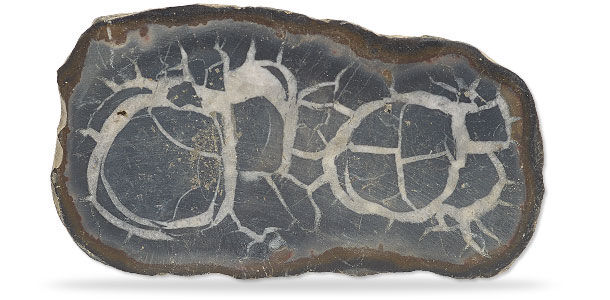Septarian
Meaning and Properties
Septarian History
Septarian specimens are believed to have formed during the Cretaceous period when sea levels were much higher. Volcanic eruptions and other occurrences resulted in the death of small sealife that then sank to into the seabed. As the specimens decomposed, sediments would accumulate and create a nodule or mud ball. When the oceans eventually receded, these mud balls were left exposed to the air and dried out, causing shrinking and cracking. The beautiful patterns you see inside septarian nodules are the result of this cracking.
Septarian Metaphysical Properties
These ancient stones have a plethora of metaphysical abilities. Many people believe septarian to be a healing stone as well as a protective stone. Septarian nurtures and grounds the wearer, bringing about feelings of happiness and understanding. This versatile stone is also a speaking stone that is said to improve communication skills of the holder. Septarian is associated with the lower chakras: root, sacral and solar plexus.
Septarian Geological Properties
Septarian specimens are geodes that are a combination of yellow calcite, brown aragonite, grey limestone and white or clear barite. The word septarian comes from the Latin word "septum," meaning "partition." Septarian nodules contain angular cavities as a result of cracking, which are called septaria and create divisions throughout the stone. These unique septaria can be any length and each septarian can have many different cracks. Calcite leeches into the cracks of septarian to form calcite crystals on a layer of aragonite, which is on bentonite clay. Eventually, bentonite is replaced with limestone, resulting in the nodule turning to stone.
Septarian stones are found along the Gulf of Mexico, all the way inland to Southern Utah. Other specimens have been discovered along Madagascar where water levels similarly receded.
|
|
|
|
|
|
Proper Care of Septarian
Gently rinse septarian with warm water to clean the specimen. Jewelry with septarian should be thoroughly dried before wear or storing. It is not recommended to use any harsh chemicals, ultrasonic devices or steam cleaners with this geode. Septarian specimens have a low Mohs hardness of 3-1/2 to 4, meaning this stone is vulnerable to scratches, divots and other surface marring as well as cracking. When storing septarian, keep the geode away from harder materials, preferably in a soft pouch or separate bead tray.
To learn more about septarian and other gemstones, order your copy of Walter Schumann's revised and expanded edition of Gemstones of the World.
Designing with Septarian
Each septarian specimen is unique with an ancient quality that makes these stones a joy to design jewelry with. Septarian usually does not have a stringing hole, which means these specimens are most commonly used in jewelry thanks to seed bead bezels, wire wrapping or macramé nets and other braiding. Using seed beads, wire or cording that coordinates with the inclusion colors of septarian helps to highlight the pattern and draw attention to the piece. Earthy tones are a favorite to incorporate with septarian, especially in the dark green, brown and taupe color ranges.
View more resources featuring septarian, including Design Ideas, Videos, Tutorials and more!
**Please note that all metaphysical or healing properties listed are collected from various sources. This information is offered as a service and not meant to treat medical conditions. Fire Mountain Gems and Beads® does not guarantee the validity of any of these statements.
How did you like this resource? Your feedback helps us provide resources that matter to you most.
Copyright Permissions
All works of authorship (articles, videos, tutorials and other creative works) are from the Fire Mountain Gems and Beads® Collection, and permission to copy is granted for non-commercial educational purposes only. All other reproduction requires written permission. For more information, please email copyrightpermission@firemtn.com.
